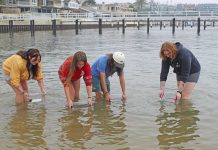
The day after Thanksgiving, Chris Welsh and the Newport Based Virgin Oceanic team got involved helping sink a 67-foot, 60-ton finback whale. The whale had apparently been hit and killed by a ship off the Southern California coast, and the carcass washed up on a San Diego beach last week.
Disposing of a dead whale is a major undertaking, and a team involving personnel from San Diego lifeguards, Scripps, Sea World, NOAA and Virgin Oceanic sank the whale in several thousand feet of water in the La Jolla undersea canyon about 10 miles off San Diego. \
Welsh was interviewed by Senior Sailing Editor John Drayton.
What did scientists and researchers learn about the whale that washed up in La Jolla?
Between marks on the body and the necropsy, there was clear evidence of a ship strike/impact that killed the whale. There were broken vertebrate and hemorrhaging in the area.
How long ago do scientists think it was killed?
Four to five days before it came ashore
How did Virgin Oceanic get involved in the project to dispose/sink the finback whale?
We had contacted NOAA to get the process started to further my goal of creating a “Whale Fall” in the Mariana Trench. A whale is a fantastic amount of food in an area like that; being able to study what shows up to dinner is a unique opportunity. We know the kind of animal life is somewhat unique to whale carcass consumption and varies with depth; we have no idea what will show up down really deep.

This was a great opportunity to understand the realities of pulling off the mission and accomplish scientific good at the same time. Scripps will be sending their ROV to visit the whale each month, and the entire thing will be a dissertation topic for a Scripps PhD student that was along for the Fall.
Shortly after our first contact, this whale (now known as “Rosebud”) came ashore and became a disposal nightmare for San Diego and an opportunity for us.
What exactly is involved in “sinking” a whale? How much weight was attached to the dead whale carcass, and how were the weights attached?
The whale is buoyant from the blubber and decomposition gases. We attached 14,000 pounds of steel scrap to the tail to overcome its buoyancy. Once the whale is down, it should stay down as the pressure collapses the remaining gas pockets.
How did the whale end up in Mission Bay (where Virgin Oceanic picked it up)?
The lifeguards towed it in so the necropsy could be accomplished and in anticipation of a land disposal at the dump.
What does a dead whale smell like?
It’s pretty strong – sort of a heavy, greasy dead animal smell with a overlay of dead fish… the oil/grease creates a slick behind the whale and coats everything in the vicinity, including the waterline of the catamaran. It’s pretty distinctive, especially after falling in during the operation and getting a healthy douse on my clothes.
What is the status of your submarine dive project?
We are very close to starting our test dives, first in a tank in San Francisco, then here in Newport. The tank gives us quick in and out while making sure all of the systems are functioning; Newport is where we will get into the actual flight behavior of the craft.
When do you think you’ll be able to head out to the Mariana Trench?
We have our final pressure test ahead; passing that will be the last hurdle before heading out. This could be several months from now.
Where can Indy readers go for more information?
They can visit www.virginoceanic.com.




